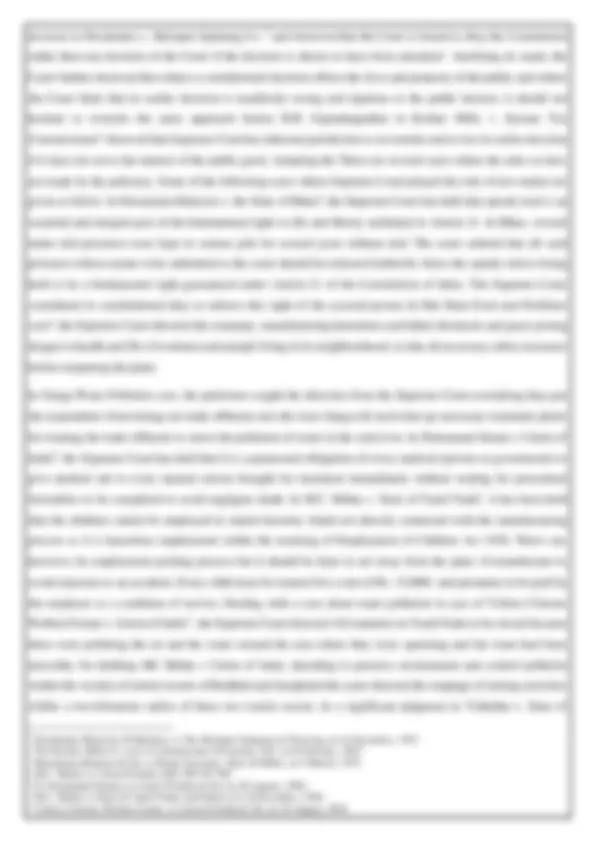





Study with the several resources on Docsity

Earn points by helping other students or get them with a premium plan


Prepare for your exams
Study with the several resources on Docsity

Earn points to download
Earn points by helping other students or get them with a premium plan
Community
Ask the community for help and clear up your study doubts
Discover the best universities in your country according to Docsity users
Free resources
Download our free guides on studying techniques, anxiety management strategies, and thesis advice from Docsity tutors
The philosophy of law through the lens of Legal Realism, a school of thought that emphasizes the social and economic factors influencing judicial decisions. the key concepts of Legal Realism, its reasons for emergence, and its impact on American and Indian legal systems. It also highlights notable figures in the movement and their contributions.
Typology: Assignments
1 / 7

This page cannot be seen from the preview
Don't miss anything!




rd
Defining Realist Thought Of Jurisprudence The realist thought has evolved as a part of American jurisprudence. They are concerned with the study of law as it works and functions which means investigating the social factors that make a law on one hand and the social results on the other. They emphasize more on what the courts may do rather than abstract logical deductions from general rules and on the inarticulate ideological premises underlying a legal system. Legal realism suggests that judicial decisions must comply with financial factors and inquiries of strategy and qualities. It is primarily based on the notion that “law is what the psychology of courts determines.” “It is the aggregate of the item of judicial and official actions.” “Law is what the judges decide.” Realists define law not as a set of legal propositions but in terms of official actions. It refers to the element of uncertainty in law and part played by the personal characteristics of the judge. This school strengthens sociological jurisprudence and perceives law as the consequence of social impacts and conditions, and sees it as judicial decisions. Meaning Of Realism The Realist movement concentrates on scientific observation of law in its meaning and working. It is called ‘Realist’ because this approach studies law as it is working and its effect. In the words of Llewellyn- “ Realism is not a school but it can be called a branch of the sociological school. It concentrates on actual working and effect of law and therefore, called the realist school.” Legal realism implies that judicial decisions must conform to socio-economic factors and questions of policy and values. This school fortifies sociological jurisprudence and recognises law as the result of social influences and conditions, and regards it as judicial decisions. Three Reasons For Realism It was a reaction against the sociological jurist who was emphasizing upon the social effect of law. It was established to ignore the ‘theory of interest’ as given by Inhering and ‘theory of social-engineering’ as propounded by Pound. It was established to point out the importance of courts and the importance of judges. American Realism Oliver Holmes: “Law is what the courts do; it is not merely what the courts say. Life of law has not been logic; it has been experience.” Gray: “Law is what the judges decide. Everything else including a statute is merely a source of law until interpreted by a court.” “Courts put life into the dead words of the statute including expert opinions, customs and public policy.” Jerome Frank: “Law is uncertain. Certainty of law is a myth.” Karl Llewellyn: He contended that the guidelines of substantive law are far less significance in the genuine routine with regards to the law that had up to this point been expected. He suggested that the point of convergence of
to Marbury? Third, if they had, might the Supreme Court have issued a writ of that kind? Concerning the first question, Marshall held that Marbury was duly named, following the procedures laid down by statute, and that he was, therefore, entitled to a writ. Second, since Marbury had a moral right to his commission, he had to be provided with a remedy by the constitution. The Chief Justice went on to claim that defending the rights of people — including against the President of the United States — was the specific responsibility of the courts. Marshall's poorly veiled lecture on the rule of law to President Jefferson was even more controversial at the time than his comment on judicial review (which doctrine was widely accepted). It was in addressing the third point, whether the Supreme Court's writ of mandamus was the appropriate solution, that Marshall raised the issue of judicial review. The Chief Justice ruled that the Court was unable to issue the writ because it was unconstitutional under Section 13 of the Judiciary Act of 1789, which gave it the power to do so, insofar as it applied to cases of original jurisdiction. Realism In The Indian Context: The legal philosophy of the realist school has not been accepted in the sub-continent for the obvious reason that the texture of Indian social life is different from that of the American life The recent trends in the public interest litigation widened the scope of judicial activism to a great extent but the judges have to formulate their decisions when the limits of constitutional frame of the law by using their interpretative skill. In other words, the judges in India cannot ignore the existing legislative statutes and enactments. They have to confine their judicial activism within the limits of the statutory law. They are free to overrule the previous decisions on the ground of inconsistency, incompatibility, vagueness, change of conditions etc. Thus the Indian legal system, though endows the judges with extensive judicial discretion, does not make them omnipotent in the matter of formulation of law. The legislative statutes and enactments, style. precedents and the rules of equity, justice and good conscience are an indispensable part of the judicial system in India. The constitution of India itself provides ample scope for the judges to take into consideration the hard realities of the socio-economic and cultural life of the Indian people while dispensing social and economic justice to them. In short, it may be reiterated that though Indian jurisprudence does not formally subscribe to the realist's legal philosophy, it does lay great stress on the functional aspect of the law to the realities of social life. Again, it refuses to accept the realist's view that Judge-made law is the only real law and other laws are worthless, but at the same time, it does not and relates completely ignore the role of Judges and the lawyers in shaping the law. Thus it would be correct to say that the Indian legal system has developed on the pattern of sociological jurisprudence as evinced by the post-independence socio-economic legislation but it considers the doctrine of realism alien to Indian society which has a different lifestyle and social milieu. Undoubtedly, the Indian judges do have the liberty of interpreting the law in its contextual and social setting keeping in view the social, economic, political, cultural, historical and geographical variations of the Indian society. The power of review and doctrine of overruling its earlier decisions has enabled the Supreme Court to effectuate the socio-economic contents of the constitutional mandate through the process of judicial interpretation and use of its inherent powers. Thus the Apex Court in Bengal Immunity Case^1 overruled its earlier (^1) Bengal Immunity Co. Ltd vs State Of Bihar & Ors on 6 September, 195 5
decision in Dwarkadas v. Sholapur Spinning Co. 2 and observed that the Court is bound to obey the Constitution rather than any decision of the Court if the decision is shown to have been mistaken". Justifying its stand, the Court further observed that where a constitutional decision affects the lives and property of the public and where the Court finds that its earlier decision is manifestly wrong and injurious to the public interest, it should not hesitate to overrule the same approach Justice B.B. Gajendragadkar in Keshav Mills v. Income Tax Commissioner^3 observed that Supreme Court has inherent jurisdiction to reconsider and revise its earlier decision if it does not serve the interest of the public good. Adopting the There are several cases where the rules or laws are made by the judiciary. Some of the following cases where Supreme Court played the role of law-maker are given as below: In Hussainara Khatoon v. the State of Bihar^4 , the Supreme Court has held that speedy trial is an essential and integral part of the fundamental right to life and liberty enshrined in Article 21. In Bihar, several under trial prisoners were kept in various jails for several years without trial. The court ordered that all such prisoners whose names were submitted to the court should be released forthwith. Since the speedy trial is being held to be a fundamental right guaranteed under Article 21 of the Constitution of India. The Supreme Court considered its constitutional duty to enforce this right of the accused person In Shri Ram Food and Fertilizer case^5 , the Supreme Court directed the company, manufacturing hazardous and lethal chemicals and gases posing danger to health and life of workmen and people living in its neighbourhood, to take all necessary safety measures before reopening the plant. In Ganga Water Pollution case, the petitioner sought the direction from the Supreme Court restraining they put the respondents from letting out trade effluents into the river Ganga till such time up necessary treatment plants for treating the trade effluents to arrest the pollution of water in the said river. In Parmanand Katara v Union of India^6 , the Supreme Court has held that it is a paramount obligation of every medical (private or government) to give medical aid to every injured citizen brought for treatment immediately without waiting for procedural formalities to be completed to avoid negligent death. In M.C. Mehta v. State of Tamil Nadu^7 , it has been held that the children cannot be employed in match factories which are directly connected with the manufacturing process as it is hazardous employment within the meaning of Employment of Children Act 1938. There can, however, be employment packing process but it should be done in are away from the place of manufacture to avoid exposure to an accident. Every child must be insured for a sum of Rs. 15,000/- and premium to be paid by the employer as a condition of service. Dealing with a case about water pollution in case of Vellore Citizens Welfare Forum v. Union of India^8 , the Supreme Court directed 162 tanneries in Tamil Nadu to be closed because these were polluting the air and the water around the area where they were operating and the water had been unworthy for drinking MC Mehta v Union of India, intending to preserve environment and control pollution within the vicinity of tourist resorts of Badkhal and Surajkund the court directed the stoppage of mining activities within a two-kilometre radius of these two tourist resorts. In a significant judgment in Vishakha v. State of (^2) Dwarkadas Shrinivas Of Bombay vs The Sholapur Spinning & Weaving on 18 December, 195 3 (^3) The Keshav Mills Co. Ltd vs Commissioner Of Income-Tax, on 8 February, 196 5 (^4) Hussainara Khatoon & Ors vs Home Secretary, State Of Bihar, on 9 March, 197 9 (^5) M.C. Mehta vs Union Of India AIR 1987 SC 965 (^6) Pt. Parmanand Katara vs Union Of India & Ors on 28 August, 198 9 (^7) M.C. Mehta vs State Of Tamil Nadu And Others on 10 December, 199 6 (^8) Vellore Citizens Welfare Forum vs Union Of India & Ors on 28 August, 199 6
Undoubtedly, judges do contribute to law-making to a certain extent but it cannot be forgotten that their main function is to interpret the law. Another criticism so often advanced against realists is that they seem to have neglected that part of the law which never comes before the court. Therefore it is erroneous evolves and develops only through court decisions. A great part of the law enacted by the legislature never comes before the court. The supporters of realist theory undermine the authority of the precedent and argue that case law is often made in haste'. without regard to wider implications. The courts generally give decisions on the spot and only rarely take time for consideration. They have to rely on the evidence and arguments presented to them in court and do not have access to wider evidence such as statistical data, economic forecasts, public opinion, survey etc. Realist school has exaggerated the role of the human factor in judicial decisions. It is not correct to say that judicial pronouncements are the outcome of personality and behaviour of the judges. There are a variety of other factors as well which has to take into consideration while reaching his decisions. The realist theory is confined to the local judicial setting of the United States and has no universal application in other parts of the world like other schools of jurisprudence. Conclusion In our current scenario of life, we often heard many circumstances wherein the application of the realist school of jurisprudence is present. Like personal interviews for admission in colleges or any job interviews, etc are conducted for detecting the ideology, traits, etc of any person, also case study approach which is done that contains many cases of various judges are studied for understanding the thinking, ideology, perception, etc of such judge to use it in the present work. Therefore, the notion and theory of this Realist school of jurisprudence assists and provide the idea to the present series of development. References: